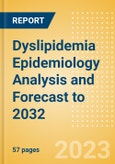1 Dyslipidemia: Executive Summary
1.1 Catalyst
1.2 Related Reports
1.3 Upcoming Reports
2 Epidemiology
2.1 Disease background
2.2 Risk factors and comorbidities
2.3 Global and historical trends
2.4 7MM forecast methodology
2.4.1 Sources
2.4.2 Forecast assumptions and methods
2.4.3 Forecast assumptions and methods: total prevalent cases of dyslipidemia
2.4.4 Forecast assumptions and methods: diagnosed prevalent cases of dyslipidemia
2.4.5 Forecast assumptions and methods: total prevalent cases of familial hypercholesterolemia
2.4.6 Forecast assumptions and methods: total prevalent cases of increased low-density lipoprotein cholesterol
2.4.7 Forecast assumptions and methods: total prevalent cases of high triglycerides
2.4.8 Forecast assumptions and methods: total prevalent cases of very high triglycerides
2.4.9 Forecast assumptions and methods: total prevalent cases of low high-density lipoprotein cholesterol
2.4.10 Forecast assumptions and methods: total prevalent cases of mixed dyslipidemia
2.5 Epidemiological forecast for dyslipidemia (2022-32)
2.5.1 Total prevalent cases of dyslipidemia
2.5.2 Age-specific total prevalent cases of dyslipidemia
2.5.3 Sex-specific total prevalent cases of dyslipidemia
2.5.4 Diagnosed prevalent cases of dyslipidemia
2.5.5 Age-specific diagnosed prevalent cases of dyslipidemia
2.5.6 Sex-specific diagnosed prevalent cases of dyslipidemia
2.5.7 Total prevalent cases of familial hypercholesterolemia
2.5.8 Total prevalent cases of increased low-density lipoprotein cholesterol
2.5.9 Age-specific total prevalent cases of increased low-density lipoprotein cholesterol
2.5.10 Sex-specific total prevalent cases of increased low-density lipoprotein cholesterol
2.5.11 Total prevalent cases of high triglycerides
2.5.12 Age-specific total prevalent cases of high triglycerides
2.5.13 Sex-specific total prevalent cases of high triglycerides
2.5.14 Total prevalent cases of very high triglycerides
2.5.15 Age-specific total prevalent cases of very high triglycerides
2.5.16 Sex-specific total prevalent cases of very high triglycerides
2.5.17 Total prevalent cases of low high-density lipoprotein
2.5.18 Age-specific total prevalent cases of low high-density lipoprotein cholesterol
2.5.19 Sex-specific total prevalent cases of low high-density lipoprotein cholesterol
2.5.20 Total prevalent cases of mixed dyslipidemia
2.6 Discussion
2.6.1 Epidemiological forecast insight
2.6.2 COVID-19 impact
2.6.3 Limitations of the analysis
2.6.4 Strengths of the analysis
3 Appendix
3.1 Bibliography
3.2 About the Authors
3.2.1 Epidemiologist
3.2.2 Reviewers
3.2.3 Vice President of Disease Analysis and Intelligence
3.2.4 Global Head and EVP of Healthcare Operations and Strategy
List of Tables
Table 1: Summary of newly added data types
Table 2: Summary of updated data types
Table 3: Risk factors and comorbidities for dyslipidemia
Table 4: Total prevalent cases of increased LDL-C, both sexes, N, ages =20 years, 2022-2032
Table 5: Total prevalent cases of high TGs, both sexes, N, ages =20 years, 2022-2032
Table 6: Total prevalent cases of very high TGs, both sexes, N, ages =20 years, 2022-2032
Table 7: Total prevalent cases of low HDL-C, both sexes, N, ages =20 years, 2022-2032
List of Figures
Figure 1: 7MM, total prevalent cases of dyslipidemia, both sexes, N, ages =20 years, 2022 and 2032
Figure 2: 7MM, diagnosed prevalent cases of dyslipidemia, both sexes, N, ages =20 years, 2022 and 2032
Figure 3: 7MM, total prevalence of dyslipidemia, men and women, %, ages =20 years, 2022
Figure 4: 7MM, diagnosed prevalence of dyslipidemia, men and women, %, ages =20 years, 2022
Figure 5: 7MM, sources used to forecast the diagnosed prevalent cases of dyslipidemia
Figure 6: 7MM, sources used and not used to forecast the total prevalent cases of high LDL-C
Figure 7: 7MM, sources used and not used to forecast the total prevalent cases of high TGs and very high TGs
Figure 8: 7MM, sources used and not used to forecast the total prevalent cases of low HDL-C
Figure 9: 7MM, sources used and not used to forecast the total prevalent cases of FH
Figure 10: 7MM, sources used to forecast the total prevalent cases of mixed dyslipidemia
Figure 11: 7MM, total prevalent cases of dyslipidemia, N, both sexes, ages =20 years, 2022
Figure 12: 7MM, total prevalent cases of dyslipidemia by age, N, both sexes, 2022
Figure 13: 7MM, total prevalent cases of dyslipidemia by sex, N, ages =20 years, 2022
Figure 14: 7MM, diagnosed prevalent cases of dyslipidemia, N, both sexes, ages =20 years, 2022
Figure 15: 7MM, diagnosed prevalent cases of dyslipidemia by age, N, both sexes, 2022
Figure 16: 7MM, diagnosed prevalent cases of dyslipidemia by sex, N, ages =20 years, 2022
Figure 17: 7MM, total prevalent cases of FH, N, both sexes, ages =20 years, 2022
Figure 18: 7MM, total prevalent cases of increased LDL-C by age, N, both sexes, 2022
Figure 19: 7MM, total prevalent cases of increased LDL-C by sex, N, ages =20 years, 2022
Figure 20: 7MM, total prevalent cases of high TGs by age, N, both sexes, 2022
Figure 21: 7MM, total prevalent cases of high TGs by sex, N, ages =20 years, 2022
Figure 22: 7MM, total prevalent cases of very high TGs by age, N, both sexes, 2022
Figure 23: 7MM, total prevalent cases of very high TGs by sex, N, ages =20 years, 2022
Figure 24: 7MM, total prevalent cases of low HDL-C by age, N, both sexes, 2022
Figure 25: 7MM, total prevalent cases of low HDL-C by sex, N, ages =20 years, 2022
Figure 26: 7MM, total prevalent cases of mixed dyslipidemia, N, both sexes, ages =20 years, 2022








